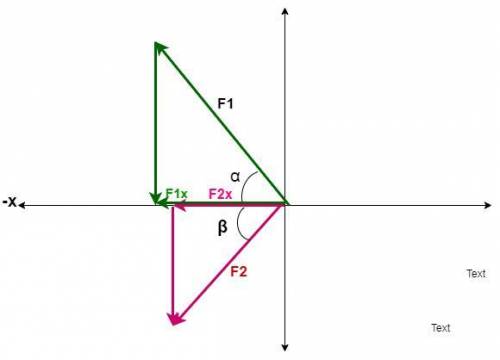
Physics, 07.10.2019 23:00, bayansayma06
Two forces, f⃗ 1 and f⃗ 2, act at a point. f⃗ 1 has a magnitude of 8.80 n and is directed at an angle of 58.0 ∘ above the negative x axis in the second quadrant. f⃗ 2 has a magnitude of 6.60 n and is directed at an angle of 53.9 ∘ below the negative x axis in the third quadrant. part a what is the x component of the resultant force?

Answers: 3
Other questions on the subject: Physics

Physics, 22.06.2019 02:10, CrownedQueen
"an open tank has the shape of a right circular cone. the tank is 6 feet across the top and 5 feet high. how much work is done in emptying the tank by pumping the water over the top edge? note: the density of water is 62.4 lbs per cubic foot."
Answers: 2

Physics, 22.06.2019 10:30, arigar
Aperson gives a shopping cart an initial push along a horizontal floor to get it moving, and then lets go. the cart travels forward along the floor, gradually slowing as it moves. consider the horizontal force(s) on the cart while it is moving forward and slowing. which of the following statements is correct? (a) both a forward and a backward force are acting on the cart, but the forward force is larger. (b) only a forward force is acting which diminishes with time. (c) both a forward and a backward force are acting on the cart, but the backward force is larger. (d) only a backward force is acting, no forward force.
Answers: 3

Physics, 22.06.2019 17:00, jenn8055
In the future, people will only enjoy one sport: electrodisc. in this sport, you gain points when you cause metallic discs hovering on a field to exchange charge. you are an electrodisc player playing the popular four disc variant. the disks have charges of qa = −8.0 µc, qb = −2.0 µc, qc = +5.0 µc, and qd = +12.0 µc. (1) you bring two disks together and then separate them. you measure the resulting charge of these two disks and find that it is +5.0 µc per disk. which two disks did you bring together? (a) a and b (b) a and c (c)a and d (d)b and c(e) b and d (f) c and d. (2) you bring three disks together and then separate them. you measure the resulting charge of these three disks and find that it is +3.0 µc per disk. which three disks did you bring together? a, b, and c (a) a, b, and d (c) a, c, and d (d) b, c, and d. (3) given the resulting charge of each disk measured in (b) is +3.0 µc, how many electrons would you need to add to a disk of this charge to electrically neutralize it? electrons
Answers: 3

Physics, 22.06.2019 17:10, lesok0818
Which statement best describes the superposition principle? a.) if two in-phase waves arrive simultaneously at a point, their amplitudes add up b.) if two out-of-phase waves arrive simultaneously at a point, their amplitudes add up c.) if two in-phase waves arrive at a point one after another, their amplitudes add up d.) if two out-of-phase waves arrive at a point one after another, their amplitudes adds up
Answers: 2
Do you know the correct answer?
Two forces, f⃗ 1 and f⃗ 2, act at a point. f⃗ 1 has a magnitude of 8.80 n and is directed at an angl...
Questions in other subjects:


History, 20.08.2019 16:30

Mathematics, 20.08.2019 16:30

Mathematics, 20.08.2019 16:30

Mathematics, 20.08.2019 16:30

History, 20.08.2019 16:30











